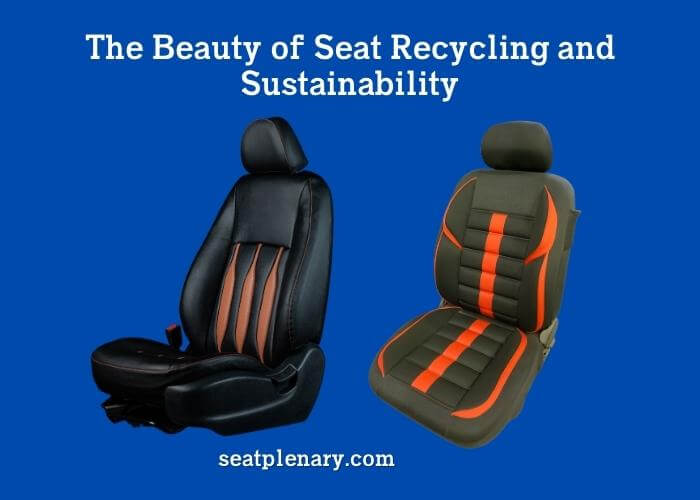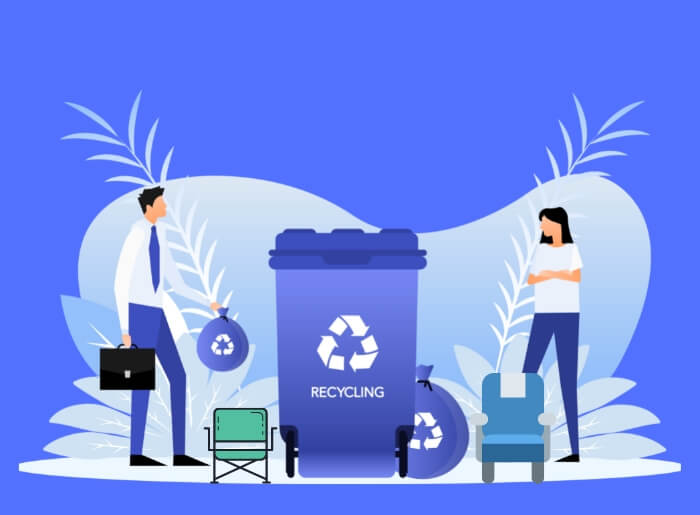Seat recycling and sustainability are becoming increasingly important in our modern world. Seat recycling refers to the process of reclaiming and reusing materials from old or unwanted seats, while sustainability refers to the practice of conserving natural resources and preserving the environment for future generations.
In this blog post, we will explore the beauty of seat recycling and sustainability, and how these practices can benefit both businesses and individuals.

By reclaiming and reusing materials from old or unwanted seats, we can minimize the amount of waste that ends up in landfills, which can have harmful effects on the environment. Seat recycling can help conserve natural resources and promote a circular economy, which emphasizes the importance of reusing materials rather than extracting and manufacturing new ones.
What is Seat Recycling?
Seat recycling is the process of taking used car seats and either refurbishing them for reuse or recycling the materials for other purposes. The process of seat recycling is beneficial both to the environment and to the automobile industry.
By taking the old car seats and either reusing them or recycling their materials, companies are able to reduce their environmental footprint and lower their costs.
Reusing car seats can be a cost-effective way to save money and reduce waste. Car seats can often be refurbished to look like new ones, making them a great option for those looking to buy used car seats.
The materials used in car seats are often highly recyclable, meaning they can be recycled into other products such as carpets, insulation, or even new car seats. This reduces the need to produce new car seats from scratch, saving resources and reducing the amount of waste sent to landfills.
The benefits of seat recycling are numerous. By reusing and recycling car seats, companies are able to reduce their costs and their environmental footprint.
The process of seat recycling can help create jobs for those in the automotive industry, as well as those in the recycling and refurbishing industries. Finally, seat recycling helps to reduce the amount of waste sent to landfills, which is a major environmental benefit.
What Type of Seat is Best for Recycling?
The best type of seat for recycling is a reusable and/or stackable seat. Reusable seats are typically made of metal, plastic, or composite materials, and are designed to be used over and over again.

They are also often designed in a way that allows them to be easily disassembled for cleaning, and for parts to be recycled. Stackable seats are made of materials that can be broken down and recycled, such as plastic, metal, or composite.
They are also designed to be stackable, allowing for easy storage and transport. Both of these types of seats are environmentally friendly since they can be recycled, reused, and reassembled multiple times.
The Benefits of Seat Recycling
Seat recycling is an important part of sustainable living, and it can have a number of benefits. Seat recycling is the process of taking old car seats and upholstery and reusing them to create something new. As you know, the seat is the primary feature of the car that determines our comfort during these journeys. This process can help reduce waste, lower costs, and even create new jobs. Here are some of the benefits of seat recycling:
1. Reduce Waste
Seat recycling can help reduce waste in landfills and in the environment. By reusing car seats, upholstery, and other materials, recycling companies can keep them from ending up in landfills and reduce the need for new materials to be produced.
2. Lower Costs
Seat recycling can help lower the cost of buying new car seats and upholstery. By reusing materials, companies can save money on production costs, meaning they can pass those savings on to their customers.
3. Create Jobs
Seat recycling can create new job opportunities. By hiring people to help with the recycling process, companies can offer more jobs to people in their communities.
4. Eco-Friendly
Seat recycling is an eco-friendly way to reduce waste and create new products. It helps to reduce the number of materials that would otherwise end up in landfills and helps to conserve natural resources.
Seat recycling is a great way to reduce waste and help the environment. By reusing materials, companies can save money on production costs and create new job opportunities. Plus, it’s an eco-friendly way to reduce waste and conserve natural resources.
The Beauty of Sustainability
Sustainability is a beautiful concept that emphasizes the importance of preserving our planet for future generations. Sustainable practices include everything from reducing waste and conserving energy to supporting local businesses and reducing carbon emissions.
Sustainable practices are not only beautiful in their own right, but they can also lead to a more prosperous and fulfilling future for all.
Seat Recycling as a Sustainable Practice
Seat recycling can be done in a variety of ways, including dismantling and reusing parts, reupholstering, and repurposing. Dismantling and reusing parts is one of the most common methods of seat recycling. This involves taking apart the seat and reusing the individual parts, such as the frame, springs, and fabric, for other purposes.
Reupholstering is a great way to give a used seat a new lease on life. This involves removing the old fabric and replacing it with new fabric, which can be done either professionally or by a hobbyist. Repurposing is another popular way to recycle a seat.
This involves taking apart the seat and using the individual parts to create something new and unique, such as a bench, a chair, or even a piece of art.
Seat recycling is an effective way to reduce waste and conserve resources. It also has the added benefit of extending the life of a product, which helps reduce the demand for new materials.
Seat recycling can help generate revenue for businesses, as many companies will pay for used seats and other materials that can be reused or repurposed. Seat recycling can help reduce the environmental impact of transportation vehicles, as recycled materials can be used to create new parts and reduce the need for manufacturing new materials.
The Future of Seat Recycling and Sustainability
In the future, seat recycling and sustainability will become increasingly important for protecting our environment and conserving resources. With the growing awareness of the importance of sustainability, more companies and organizations will begin to focus on recycling their used seats. This will involve taking apart the seat components and either reusing them or breaking them down into raw materials which can be used to manufacture new products.
One of the key ways that seat recycling and sustainability will be improved in the future is through the development of more efficient recycling technologies. For example, new technologies such as 3D printing can allow companies to create new products from recycled materials. Additionally, new materials such as plastics and synthetic fabrics can be used to create more durable and eco-friendly seats.
There will be a greater focus on the reuse of used seats. This can involve refurbishing and reselling used seats, or donating them to schools, community organizations, and other non-profits. This not only helps the environment by reducing the amount of waste that goes into landfills, but it also provides an affordable and sustainable alternative for those who are in need of new seating.
Seat recycling and sustainability will continue to be a major focus for companies and organizations in the future. By utilizing more efficient recycling technologies, using more eco-friendly materials, and focusing on the reuse of used seats, we can ensure that our environment is protected and that resources are conserved.
The Bottom Line
Seat recycling and sustainability have been great ways to help reduce the amount of waste that is produced in our environment. It is important to remember that sustainability and seat recycling can also help reduce the amount of pollution and emissions that are produced from production and waste disposal.
This is the beauty of seat recycling and sustainability – it not only provides us with a way to reduce our environmental impact, but it also helps us to save money and resources in the process.
If you want to know about seat belts and airbags, See here for this.
Relevant Resources:
